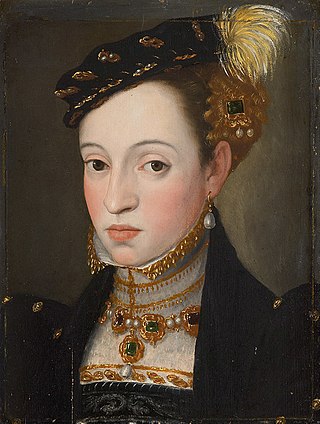Related Research Articles
Pope Eutychian, also called Eutychianus, was the bishop of Rome from 4 January 275 to his death on 7 December 283.
Pope Theodore I was the bishop of Rome from 24 November 642 to his death. His pontificate was dominated by the struggle with Monothelitism.

The Encyclopædia Britannica Eleventh Edition (1910–1911) is a 29-volume reference work, an edition of the Encyclopædia Britannica. It was developed during the encyclopaedia's transition from a British to an American publication. Some of its articles were written by the best-known scholars of the time. This edition of the encyclopaedia, containing 40,000 entries, has entered the public domain and is easily available on the Internet. Its use in modern scholarship and as a reliable source has been deemed problematic due to the outdated nature of some of its content. Modern scholars have deemed some articles as cultural artifacts of the 19th and early 20th centuries.

The Kingdom of France was organised into provinces until the National Constituent Assembly adopted a more uniform division into departments (départements) and districts in late 1789. The provinces continued to exist administratively until 21 September 1791.
In Roman mythology, Laverna was a goddess of thieves, cheats and the underworld. She was propitiated by libations poured with the left hand. The poet Horace and the playwright Plautus call her a goddess of thieves. In Rome, her sanctuary was near the Porta Lavernalis.

In ancient Roman religion, the Arval Brethren or Arval Brothers were a body of priests who offered annual sacrifices to the Lares and gods to guarantee good harvests. Inscriptions provide evidence of their oaths, rituals and sacrifices.
Acta Diurna were daily Roman official notices, a sort of daily gazette. They were carved on stone or metal and presented in message boards in public places such as the Forum of Rome. They also were called simply Acta. In many ways, they functioned like an early newspaper for the Roman citizenry. The Acta were begun in 59 BC and continued until AD 222.

Eleanor of Austria, also called Eleanor of Castile, was born an Archduchess of Austria and Infanta of Castile from the House of Habsburg, and subsequently became Queen consort of Portugal (1518–1521) and of France (1530–1547). She also held the Duchy of Touraine (1547–1558) in dower. She is called "Leonor" in Spanish and Portuguese and "Eléonore" or "Aliénor" in French.

Ferdinand II, Archduke of Further Austria was ruler of Further Austria and since 1564 Imperial count of Tirol. The son of Ferdinand I, Holy Roman Emperor, he was married to Philippine Welser in his first marriage. In his second marriage to Anna Juliana Gonzaga, he was the father of Anna of Tyrol, future Holy Roman Empress.

Archduke Ernest of Austria was an Austrian prince, the son of Maximilian II, Holy Roman Emperor, and Maria of Spain.

Catherine of Austria was Queen of Portugal as wife of King John III, and regent during the minority of her grandson, King Sebastian, from 1557 until 1562.
Acta Senatus, or Commentarii Senatus, were minutes of the discussions and decisions of the Roman Senate. Before the first consulship of Julius Caesar, minutes of the proceedings of the Senate were written and occasionally published, but unofficially; Caesar first ordered them to be recorded and issued authoritatively in the Acta Diurna. The keeping of them was continued by Augustus, but their publication was forbidden. A young senator was chosen to draw up these acta, which were kept in the imperial archives and public libraries. Special permission from the city prefect was necessary in order to examine them.

Via Nomentana is an ancient road of Italy, leading North-East from Rome to Nomentum, a distance of 23 km (14 mi). It originally bore the name "Via Ficulensis", from the old Latin village of Ficulea, about 13 km (8.1 mi) from Rome. It was subsequently extended to Nomentum, but never became an important high road, and merged in the Via Salaria a few kilometers beyond Nomentum. It is followed as far as Nomentum by the modern state road, but some traces of its pavement still exist.
Dominus is the Latin word for master or owner. Dominus saw use as a Roman imperial title. It was also the Latin title of the feudal, superior and mesne, lords, and an ecclesiastical and academic title. The ecclesiastical title was rendered through the French sieure in English as sir, making it a common prefix for parsons before the Reformation, as in Sir Hugh Evans in Shakespeare's Merry Wives of Windsor. Its shortened form Dom remains used as a prefix of honor for ecclesiastics of the Catholic Church, and especially for members of the Benedictine and other religious orders. The title was formerly also used as is, Dominus, for a Bachelor of Arts.
Fescennia or Fescennium was an ancient city of Etruscan/Faliscan origin, which is probably to be placed immediately to the north of the modern Corchiano, 6 miles (9.7 km) north west of Civita Castellana, in central Italy. The Via Amerina traverses it. At the Riserva S. Silvestro, walls exist. At Corchiano itself, however, similar walls may be traced, and the site is a strong and characteristic triangle between two deep ravines, with the third (west) side cut off by a ditch. Here, too, remains of two bridges may be seen, and several rich tombs have been excavated.

Charles II Francis of Austria was an Archduke of Austria and ruler of Inner Austria from 1564. He was a member of the House of Habsburg.

Arruns Tarquinius, commonly called Egerius, was a member of the royal family of early Rome.
The Via Sublacensis was a Roman road constructed to connect Nero's palace in present-day Subiaco to Rome, splitting off from the Via Valeria near Varia, about 10 km northeast of Tivoli.

Eleanor of Austria was Duchess of Mantua by marriage to William I, Duke of Mantua. She was the daughter of Ferdinand I, Holy Roman Emperor and Anna of Bohemia and Hungary.

Magdalena of Austria was a co-founder and first abbess of the Ladies' Convent of Hall, born an archduchess of Austria from the House of Habsburg as the daughter of Ferdinand I, Holy Roman Emperor.
References
This article incorporates text from a publication now in the public domain : Chisholm, Hugh, ed. (1911). "Album". Encyclopædia Britannica . Vol. 1 (11th ed.). Cambridge University Press. p. 513.
- Chisholm, Hugh, ed. (1911). . Encyclopædia Britannica . Vol. 1 (11th ed.). Cambridge University Press. p. 513.
- Chisholm, Hugh, ed. (1911). . Encyclopædia Britannica . Vol. 1 (11th ed.). Cambridge University Press. p. 159.